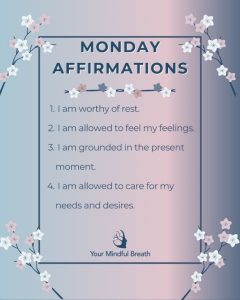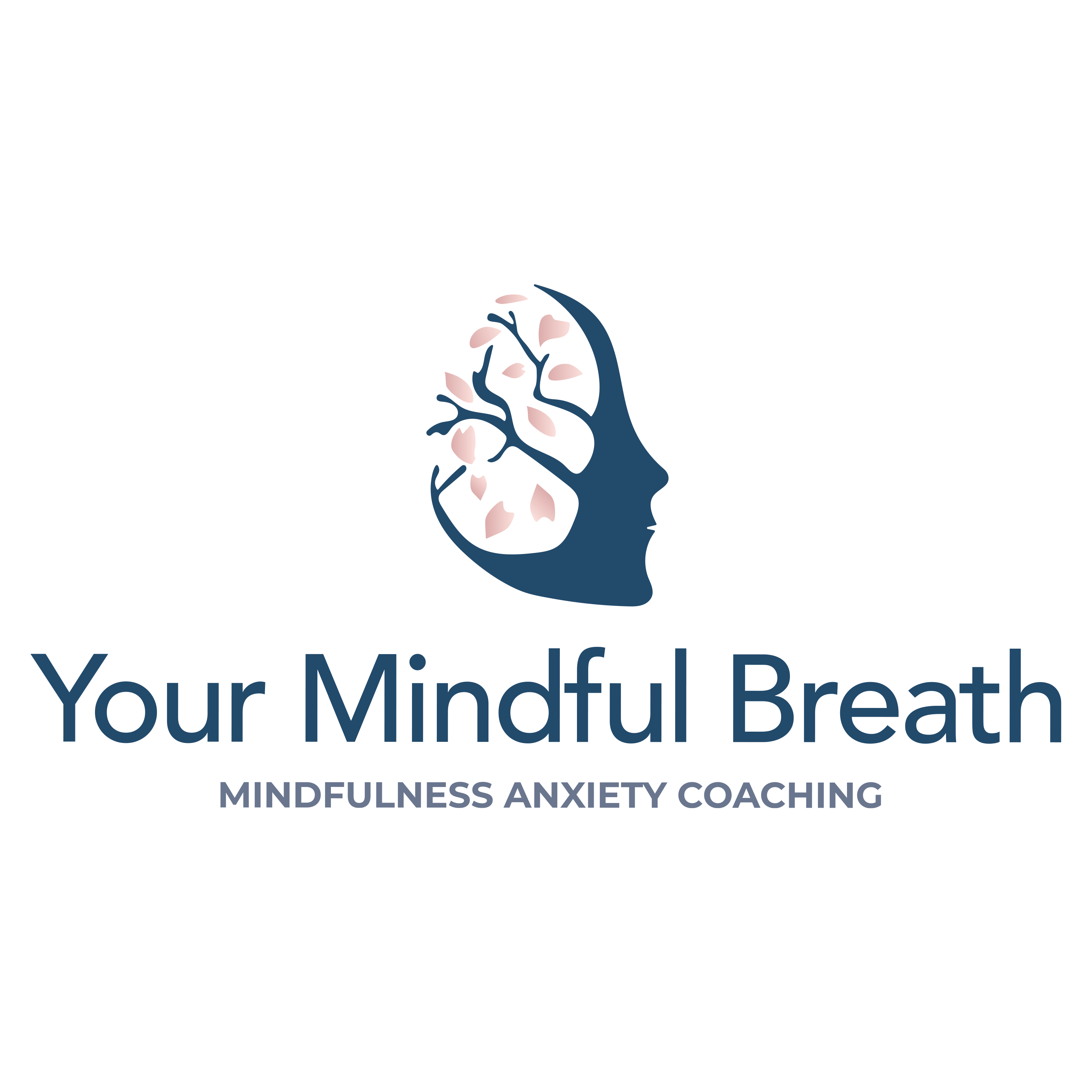According to the Mayo Clinic, anxiety is “Intense, excessive, and persistent worry and fear about everyday situations. Fast heart rate, rapid breathing, sweating, and feeling tired may occur.”
Anxiety can be a typical or normal reaction to stressful situations, such as when taking a test at school, when anticipating lab results, during a pandemic or speaking in front of large groups.
Most often this anxiety is being driven by thoughts or feelings about future outcomes or events or things that have already happened. Very rarely is anxiety related to what is happening in the present moment.
Try self-soothing to help ease the anxiety during more stressful events, even in the moments that it occurs.
#1) Physical Grounding
Having a lot of anxiety can make you feel like you are not connected to anything and that you may just drift away. Physical grounding can help to soothe your anxiety. To ground yourself, try using at least one of your senses to connect with the present world around you.
You might give this 5 Senses Meditation a try. This meditation involves connecting with your 5 senses of sight, touch, sound, smell, and taste.
 You could also try activities such as smelling a candle, focusing your attention on a singular object, noticing the taste of the food you’re eating or the smell in the environment around you. A more common way to practice grounding is to connect your feet to the ground and simply notice what it feels like as your feet touch the ground. A distraction-free or cell-phone free walk can also be a wonderful way to ground in the present moment.
You could also try activities such as smelling a candle, focusing your attention on a singular object, noticing the taste of the food you’re eating or the smell in the environment around you. A more common way to practice grounding is to connect your feet to the ground and simply notice what it feels like as your feet touch the ground. A distraction-free or cell-phone free walk can also be a wonderful way to ground in the present moment.
#2) The Worry Jar
The worry jar is a great way to let go of your worries using an easy ritual.
The Virtual Jar
- Close your eyes.
- Imagine that you write down all your worries on a piece of paper
- Fold the paper and put it in the jar.
- Once it is in the jar, imagine closing the lid and putting the jar away.
By putting your worries in the jar and then putting the jar away, you are telling yourself that you are not going to be anxious about those worries right now. This can help you gain clarity and focus on why you are anxious.
If you want, you can also do the worry jar exercise with physical paper and jar. This can help if you are having a hard time envisioning the virtual jar.
#3) Affirmations
Positive affirmations are statements in regard to any issue that are repeated as if they are the current reality (even if they are not). When you repeat a positive affirmation, it helps to program your mind to the end result you want to achieve.
Your affirmation is something that you can repeat many times throughout the day. Don’t limit yourself to just one affirmation. You can make a long list of affirmations aimed at reducing anxiety and maintaining calm and peace.
You can also write down positive affirmations and place them in areas where you will see them such as a mirror, on your computer or maybe even your front door!
Examples Of Affirmations For Anxiety
- I am calm and centered.
- I feel at peace.
- My world is peaceful and serene.
- Every breath I take I inhale peace and let go of worry.
 I share affirmations for anxiety every Monday on my instagram. These are one of my favorite ways to help me handle anxious or difficult situations. Here’s an example below of a Monday Affirmation.
I share affirmations for anxiety every Monday on my instagram. These are one of my favorite ways to help me handle anxious or difficult situations. Here’s an example below of a Monday Affirmation.
#4) Journaling
Journaling can be very helpful to soothe your anxiety. Writing down how you feel can help you process those emotions that are sometimes hard to put into words.
Journaling includes free writing on paper, poetry, doodling, writing down random thoughts or any other method that helps to soothe your anxiety. It is your journal, and you can self-soothe anytime that you need to help keep your anxiety at bay.

#5) Breathing Exercises
When you are anxious, your breathing can get become erratic. Breathing exercises can help to calm you and promote inner peace and serenity. Deep breathing calms your body and the physical reactions to stress and anxiety, but it also helps calm your mind at the same time.
Method: A good technique is called Box Breath or Square Breath. For this breath technique count to 4 seconds on the inhale, hold for 4 seconds, then exhale for 4 seconds and hold for 4 seconds. Here’s a guided example of Box Breath.
There are many other breathing exercises available which I have a several on Insight Timer.
Looking up a few ahead of time and knowing how to practice them can be very helpful for when you are feeling anxious.
Below are a few of my other favorite breathing techniques to help me ground and soothe my anxiety.
Give them a try and see which ones feel good for you! These breath techniques range from just three to ten minutes.
It’s important to try and practice these before anxiety strikes because sometimes learning something new when you’re feeling anxious can be a lot harder to process and may even cause more stress.
If you’d like to learn more ways to self-soothe join the Facebook Family at Facebook.com/groups/apathwaytopeace.
Please note I’m not a medical professional and the tips I provided are ones that have personally helped me. I highly recommend speaking with your medical doctor if you’re struggling with anxiety you can’t manage. Also, please remember seeking help does not make you weak! We are all a little different and one person’s solutions aren’t going to be perfect for everyone.





